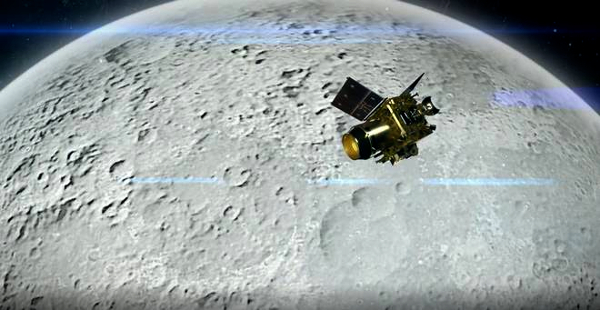As it awaits the arrival of its successor in August this year, Chandrayaan-2 has once again found new developments happening under the surface of the Moon. Chandra’s Atmospheric Composition Explorer-2 (CHACE-2) instrument onboard Chandrayaan-2 has found Argon-40 in the tenuous lunar exosphere.
The new observations provide insight into the dynamics of the lunar exospheric species and activities in the first few tens of meters below the lunar surface that could pave the way for understanding the composition of the lunar surface. The observations show the presence of Argon in the equatorial and mid-latitude regions of the Moon. While it’s not the first time that Argon-40 has been detected on the Moon, so far these detections had been limited to near-equatorial regions as seen by the Apollo-17 mission.
The latest findings have been published in the journal Geophysical Research Letters.
WHAT IS ARGON-40?
An inert, colorless and odorless element, Argon is a noble gas. The vast majority of Argon on Earth is the isotope Argon-40 that originates from the radioactive disintegration of Potassium-40 (K-40) present below the lunar surface. According to Isro, once formed, it diffuses through the inter-granular space and makes its way up to the lunar exosphere through seepages and faults.
The lunar exosphere is the outermost region of the upper atmosphere of the Moon where the constituent atoms and molecules rarely collide with each other and can escape into space. “Earth’s Moon features a surface-boundary-exosphere. For the Moon, different constituents in the exosphere are fed from the surface by a variety of processes, such as thermal desorption, solar wind sputtering, photo-stimulated desorption, and micrometeorite impact vaporization. The exospheric atoms may be lost to space by the thermal escape,” Isro said.
WHAT DID CHANDRAYAAN-2 FIND?
Led by M. B. Dhanya of the Vikram Sarabhai Space Center, the team of astronomers found an increase in the density of Argon-40 near the sunrise terminator, a decrease along the dayside, a secondary peak near the sunset terminator, and a night-side minimum. However, the biggest revelation was that the density of Argon-40 with respect to solar longitudes is similar to that of low latitude regions, despite the differences in temperature and topography.
“The observations of the Argon bulge by CHACE-2 are indicative of unknown or additional loss processes, Moon quakes or regions with lower activation energies, which call for a better understanding of the surface-exosphere interactions and source distributions of Ar-40,” Isro said.
The CHACE-2 was a sequel to the CHACE experiment on the Moon Impact Probe (MIP) of Chandrayaan-1 mission and also draws heritage from the Mars Exospheric Neutral Composition Analyser (MENCA) experiment aboard the Indian Mars Orbiter Mission.
Source: India Today
You may also like
-
New Heat-Based Approach To Cancer Treatment Can Reduce Chemotherapy Doses
-
Scientists Take A Major Step Towards Unification Of Classical & Quantum Gravity
-
India Graphene Engineering and Innovation Centre (IGEIC) Under the Vision of Viksit Bharat@2047 Launched
-
New High-Performance Gas Sensor can Monitor Low Level Nitrogen Oxides Pollution
-
Antidepressant Drug can be Repurposed for Treating Breast Cancer
